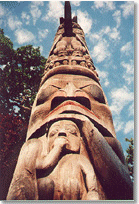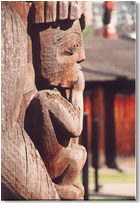Thunderbird Park
Interview with Peter Macnair continued..
July 6, 1999
 Skim-sim and Will-a-daugh Pole (Totem Mother) Skim-sim and Will-a-daugh Pole (Totem Mother)
Emily Carr traveled up the Skeena River and managed to get to Gitanyow in 1928 where she sketched this pole. The figure on the base was of a great interest to her and is the subject of a major oil painting, "Totem Mother, Kitwancool", now in the collection of the Vancouver Art Gallery. The pole itself belongs to one of the Wolf clans of that village. The figure on the top is known as the Giant Woodpecker. Next is a group of small human-like creatures; they are variously said to represent the structure of the house to which this totem pole belongs.
 Below is a great bird called Skim-sim in the Gitxsan language; it is the Mountain Eagle, a mythic bird of considerable power. Below the Mountain Eagle are several human figures with arms in various aspects, and these are known in the ethnographic record as either children or "little people". There are stories that recount how, in the winter, people survived by fishing through the ice and these little characters are fishing through holes in the ice of the river or lake. Below is the major and main ancestress of the people of this particular lineage. According to some accounts, she holds her child in her arms.
Below is a great bird called Skim-sim in the Gitxsan language; it is the Mountain Eagle, a mythic bird of considerable power. Below the Mountain Eagle are several human figures with arms in various aspects, and these are known in the ethnographic record as either children or "little people". There are stories that recount how, in the winter, people survived by fishing through the ice and these little characters are fishing through holes in the ice of the river or lake. Below is the major and main ancestress of the people of this particular lineage. According to some accounts, she holds her child in her arms.
 Emily Carr's pencil sketch of the "Totem Mother" figure shows that the child's right forearm is missing; earlier it had broken off the original pole. In her studio oil Carr replaced the hand, resting it on the child's chest. When Mungo carved the replica, he extended the right arm so that the hand is again in the child's mouth, as it was on the original pole.
Emily Carr's pencil sketch of the "Totem Mother" figure shows that the child's right forearm is missing; earlier it had broken off the original pole. In her studio oil Carr replaced the hand, resting it on the child's chest. When Mungo carved the replica, he extended the right arm so that the hand is again in the child's mouth, as it was on the original pole.
Page Three
|

